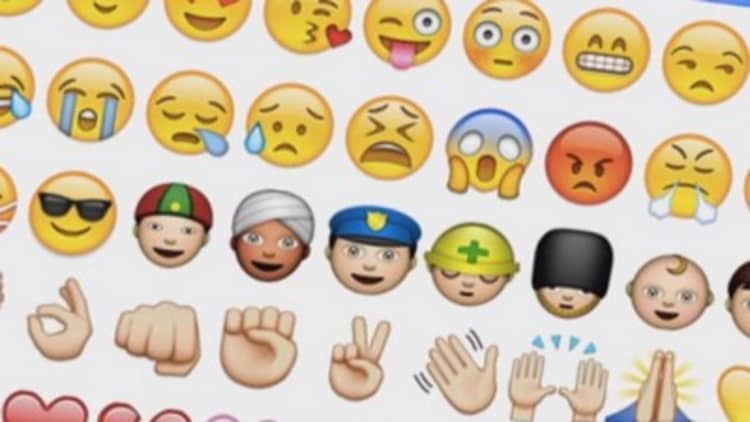You know you've done it. Someone sends you an encouraging note and you don't have time to respond with a lengthy answer…so what do you do? You pick an emoji that vaguely matches your response.
Or what about when you receive a flirty text? You're not sure about how you feel, so what do you do? You use an emoji.
But could these pictorial short-cuts be signalling something way more sinister – like the death of the written word?
Emojis – a Japanese term which translates to "picture and character" – first surfaced in 1998. But it wasn't until major smartphone players like Apple integrated emojis into their operating system, that their use took off.
The emergence of new picture icons -- like a smiley brown poop or the broken heart -- over the past couple of years have added personality to our text message conversations.
"Emoji(s) get picked up because they are so useful for enriching text with the kinds of things we might use our intonation or facial expressions to convey," said Tyler Schnoebelen, executive at language data company Idibon, who has a PhD in linguistics from Stanford.
Companies have also been participating in this new trend. Chevrolet recently issued a press release in emojis, challenging individuals to decode its announcement, while a version of William Shakespeare's "Romeo and Juliet" has been retold using "textspeak" like LOL and, of course, the ubiquitous emoji.
Read More37 new emojis have been revealed to the world
Tech enthusiast and CEO of Hotel Tonight, Sam Shank, says: "Emojis got popular because as people on mobiles write shorter and shorter messages to each other, it is hard to convey exact meaning.
"For example, does saying that something is 'interesting' mean that it is 'very cool' or 'really lame' or 'I'm horrified'?" This is actually much easier to convey using emojis, he added.

A very informal and unscientific survey I conducted on the streets of London revealed a wide range of responses about the use of emojis.
"I can't remember one text message conversation I've had over the past 10 days that did not include an emoji," said a teenager who goes to school in Notting Hill.
"Once you use one emoji, you just want more and more," said an Imperial college student in London.
And it's this appetite for more emojis that has resulted in the birth of new mobile apps that offer users millions of symbols to choose from - ranging from smiley puppy dogs to 3-D fish.
"It's long been the case in Asia, where emojis have run rampant on chat platforms Kakao, Line and Wechat. In fact, buying new emoji stickers has become a new multibillion-dollar industry," said U.S. entrepreneur and Founding General Partner of Eniac Ventures, Nihal Mehta.
Over the past couple of years we've seen new apps like Emoji Free, Emoji ++, SMS Rage Faces, and KeyMoji come to market. There is even "emoticon art" that allows you to customize and create your own cartoon images.
While emojis were first used in addition to a written text…you're finding that a larger group of tech-savvy millennials are replacing words with cartoon symbols to convey a message.
This should be ringing alarm bells. My worry is not society's use of emojis to add a little fun and pizazz to a conversation, but the increasing reliance on the different smileys or hand gestures to communicate a feeling or expression.
Why do we look up to William Shakespeare or Charles Dickens? Because they beautifully captured moments of life in the written language that even to this day is held in high regard - and applicable to society in the year 2015.
What has our digital revolution created that will be celebrated by our grand kids and their kids? Smiley brown poop?
But what our generation leaves behind is the least of our worries.
Read MoreEmojis could replace your bank PIN
The growing use of these icons could potentially lead to further miscommunication. Ben Zimmer, executive editor of Vocabulary.com, says it's the emoji's ambiguous meaning that could lead to confusion because users can look at an emoji and take different things from it.
Here's one example Zimmer provided: the emoji that illustrates two folded hands. According to Zimmer, this emoji started in Japan where the symbol represented salutation or gratitude. Other cultures interpret this emoji to symbolize prayer, while millennials often see this symbol belonging to two different people giving each other a high five.

Another potential issue is that the tone of someone's voice can be lost when a text message is used to converse, resulting in the recipient not always grabbing the full meaning.
"The person you're sending them to may not know the meaning of an emoji - or misinterpret it," said Hotel Tonight's Shank.
You don't need to be a psychologist to understand what happens next. New relationships - solely predicated on the use of text in the early days - can lead to lost love if you fail to recognize what your potential partner is trying to say.
Read MoreGIFs are shaking up texting as we know it
The other obvious disadvantage is learning how to decode emojis, especially when they are stacked one after another, and get more complicated as they grow, added Eniac Ventures' Mehta.
But this is increasingly difficult as the toolbox of emojis increases and the use of these symbols changes depending on the context and culture.
Language and communication classes are incorporated into a school's curriculum to teach students how to use words to tell a story and communicate effectively. If these classes need to incorporate the language and symbols used in the mobile/digital world, aren't we just regressing back to the age of hieroglyphs?
As Shakespeare once said: "A fool thinks himself to be wise, but a wise man knows himself to be a fool."
If only William was here to comment on emojis.


